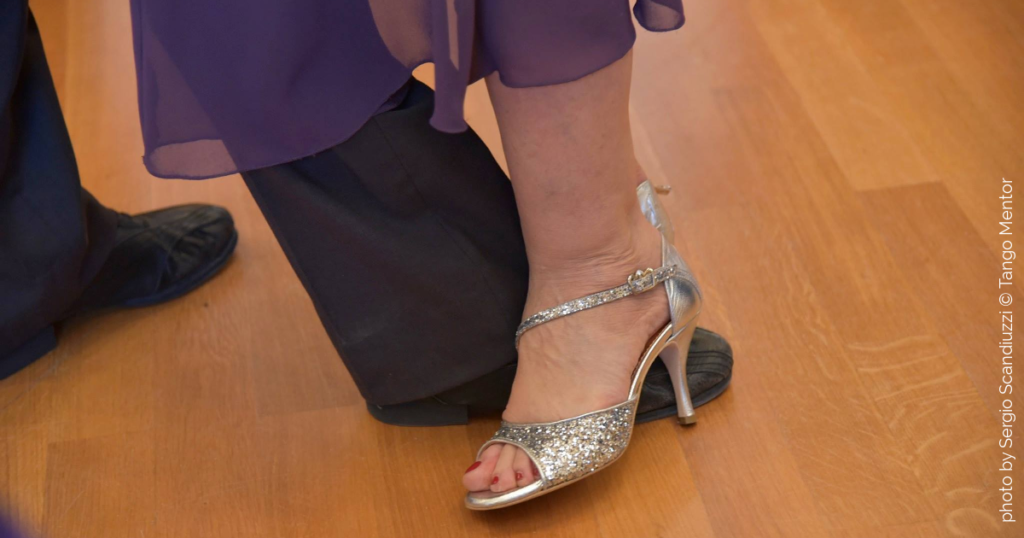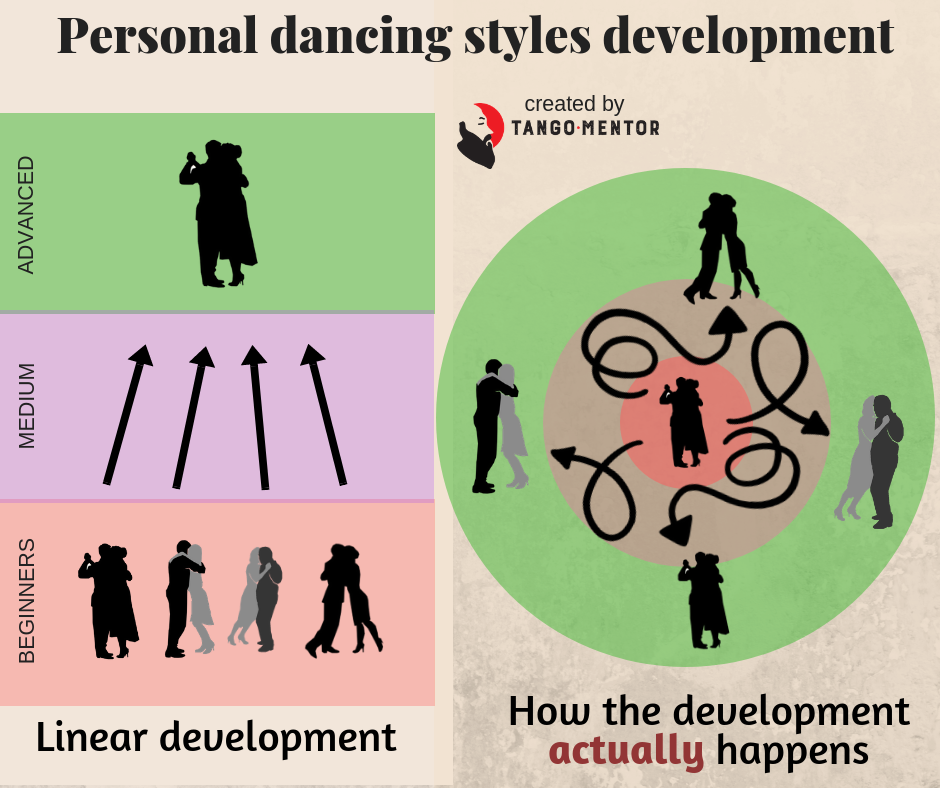 What is tango? I don’t believe that there is a consistent definition of what tango is. It is so personal that only relevant question should be “What tango is for you?”
What is tango? I don’t believe that there is a consistent definition of what tango is. It is so personal that only relevant question should be “What tango is for you?”
Some people come for the connection others for the passion; some come for the acrobatics other for the elegance; some come for sensuality, others for the friendships. There are so many preferences, so many layers and combinations.
In this article I am going to share with you some lessons I learned about personal tango styles.
“Do you know what just happened?”, she said with offended look on her face. “He just told me not to lean on him, because I limit his movements.”
She was a friend of mine with whom we decided to travel together to few events. This event in particular was a very famous one. It was always visited by high level dancers, but they all danced differently. It was a mixture of styles and approaches.
“Well, I could have told you if you asked me. He has different style than yours!”, I answered.
Yes, he was a good dancer, but the way he danced was opposite of what she needed in the dance. The style that was taught in her school was very similar to my own, so I loved to dance with her – but, the same thing I liked, others disliked. The reason was simple – he had different style.
Here are some simple lessons I learned about styles:
1. There is no right way – There is no one ultimate dancing style that is “the right way”. I would say, there is only “the right way” for you. What you do always depends on what you want to achieve. It’s so simple truth, but so many people waste time and energy trying to persuade people that they are wrong.
The sooner you accept this, the better are your chances to have good times in milongas or international events.
Hey, sorry to interrupt…
Do you like reading my articles? If you do please consider a small contribution to the existence of this blog.
I don’t sell a book or run ads: I share these articles for free. Unfortunately I also have to pay my bills, so if you see value in my work please consider a small donation/gratuity (the same way you tip your favorite bartender).
From my heart to yours!
Ivica
Securely processed via PayPal
2. You can’t dance all styles at the same time – Some dancers are good in adapting the way they dance and that is great skill to have. However, there is a limit: dancers can adapt, but they can’t change. You dance the way you think about your dancing – you can add or take out some energy, dance with more or less steps, do this or that – but, at the end you are still dancing as you are.
Experienced observer can guess what is the style of a dancer even before he even steps on to the dance floor. Even taking notice of things like shoes, pants, belt or hairstyle can give you clues.
3. Accept and tolerate – People get so obsessed with tango that they often behave like religious fanatics. This is specially visible in the clash of the styles. It was present in the past and it is still to this day.
Let others dance the way they believe is a good way; the way they feel the music. You don’t have to like it. Only people that have to like it are their dancing partners.
I have to make a note here: only unacceptable or intolerable style is the one that is not adapted to dancing in social context. This means if you kick and bump in to other couples disrespecting their right to have nice time – you should not be allowed on the dance floor.

4. Choose ones you like – Remember the story of my friend? The one with the dancer who told her that she is limiting his movements. I would ask him something: was he aware that with his movements he is limiting her opportunity to enjoy the embrace?
So, who was right? Both and neither. They should have payed more attention before choosing the partner. Of course, you don’t give lectures like that during the tanda – he should have kept his mouth shout, finish the tanda and never invite her again if he didn’t like the dance.
If you like to experiment with new partners with different styles, be prepared to encounter some who can’t or don’t want to give you what you want from the dance.
The form you have selected does not exist.
5. Monkey see, monkey do – Many things in tango depend on what you consume visually. This is very important in the development of your dancing style.
There is a reason why I always tell my students to be extra cautious with what they watch on Youtube. Many will disagree with me, but watching show dancing videos or performances on festivals is actually working against your ability to dance in crowded milongas. Watching videos gives you ideas about musicality, and artistic show musicality is often unusable when you have limited space and a partner with limited abilities. You can’t kick others with ganchos or boleos just because you want to accent a particular note in the song just like your tango idol did in his performance.
So, what is the conclusion…. There is no conclusion. Tango is no one way street and that is the beauty of it: we can be what we are without feeling that we are doing something wrong.
Did you find this article useful? If so, please share it with your tango friends on Facebook or other ways you communicate with them.

There are no doubts, no discussion, when you feel The Tango.
https://m.youtube.com/watch?v=BbEyGUQkcFQ
http://www.todotango.com/musica/tema/1772/Danza-maligna/
While I agree that there are many different styles of tango, there are a few points in this article I disagree with. These comments come from a woman’s point of view so I probably see things differently than you do.
First, I have always been taught that the woman establishes the embrace, not the man. I have hear this from my instructors in Buenos Aires, London and even in the US. For a man to say that he needs his space is almost an embarrassment to his level of tango. Perhaps he can only do what I have often heard referred to as salon-stage and is incapable of dancing a traditional milonguero tango.
Second, the open embrace can be potentially dangerous to the follower. Without the communication that the close embrace allows, the leader cannot feel where the follower’s center of balance is or where the shared axis is. This information cannot be communicated in an open embrace by looking at the follower’s upper torso because a good dancer disassociates upper and lower body to execute turns and pivots smoothly. I have suffered two minor injuries that prevented me from dancing for several months because a leader initiated a turn/pivot before my body was centered over the standing leg. I will no longer dance with a man who dances open embrace.
Having spent a total of 10 months in Buenos Aires on several different trips, I can say that among the traditional dancers, you never see an open embrace. If you do, it is usually a tourist or beginner. However, I do not attend the midnight to 6 am milongas so I cannot speak for this group.
Hey Catherine, thanks for thr comment. I read few times what you wrote, but I cantl’t see where we disagree I feel that we agree 100%
While I don’t disagree with you, men need to understand that women establish the embrace – something that I think should have been pointed out in the first part of the article instead of saying there are many different styles. I bring this up because a tango acquittance sent the article to me as an excuse for dancing an open embrace. Too many men use an open embrace because it is easier to learn but it puts the follower’s knees at risk when he starts whipping her around in dramatic moves without any thought to her center. I feel backing off on this as an issue under the pretext of different styles was missing what could have been a good instructional point.
Hey Catherine, over the years working on this blog I learned that people are rarely objective – they tend to see what they want to see, no matter how hard I try to explain. So, I stopped trying!
In your situation, I would just smile back to the friend thanking him for sharing the article – no need to argue over this. No one changed the way of his dancing with arguing.
And, as I said in the article, if you don’t like each other’s way of dancing – don’t dance with each other 🙂
see, thats the first remark i see about the “religiously fanatics” in Tango. it feels sometimes like some “true believers” gone on crusade…. 😉
as i come to the dance with lots of background of social dancing (to be separated from the glamours and tournaments) waltz, rumba, quickstep, salsa, … i don’t think Tango Argentino is so much different. Everyone just keeps Talking you into this.
there are only two (2) points that decide if you dance good or bad.
1. you feel good while dancing.
2. and most important – your current partner dances with you again on the next opportunity – then you know it has been good for her/him also and thats all that really counts.
You can’t do well with everybody and with some it’s good and some are good for a drink at the bar. And the good/bad partners evolve like you and change also, so in a few months you might be surprised that it’s not good anymore or better than ever…
so…stop complaining and go dancing, have fun, meet new people
Good insights Tom… thank you for sharing them!